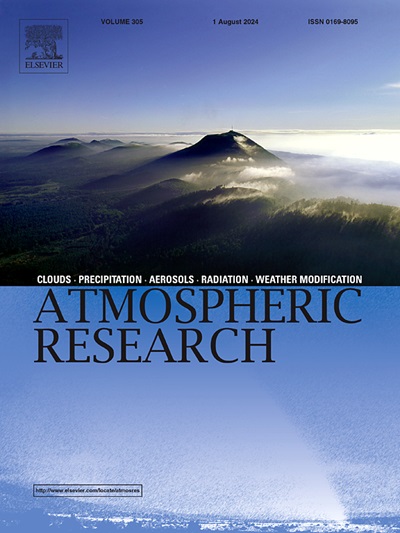丹江口水库周边湿沉积中溶解有机碳:时间格局、来源及其生态意义
IF 4.5
2区 地球科学
Q1 METEOROLOGY & ATMOSPHERIC SCIENCES
引用次数: 0
摘要
尽管人们认识到大气溶解有机碳(DOC)湿沉降的重要性,但对其在大型水库集水区的动态仍知之甚少。研究了丹江口水库周边城市、农区和库区雨水DOC浓度和沉积通量的时空变化特征。体积加权平均(VWM) DOC浓度变化显著,与农业(4.94 mg C L−1)和库区(4.66 mg C L−1)相比,城市地区的最高水平为7.52 mg C L−1。DOC浓度的升高出现在春季和冬季,这可能是由于降雨清除减少、加热排放增加以及有利于污染物积累的稳定大气条件所致。来源分配表明,陆地对雨水DOC的贡献占主导地位。农业活动、矿物粉尘和移动排放与农业和库区的DOC有关,而煤炭燃烧和工业排放等固定源对城市地区的贡献更大。逐步多元回归分析发现降雨量和电导率(EC)是DOC浓度的显著预测因子,反映了大气冲刷和陆地影响。不同站点的月DOC通量在0.24 ~ 14.12 kg C ha - 1之间,突出了降水驱动的时间变率。夏季是各区域DOC沉积通量最高的季节(16.43 ~ 25.88 kg C ha - 1),是春季和冬季的2倍以上。市区DOC年沉积通量最高(56.07 kg C ha−1 yr−1),其次是水库(34.77 kg C ha−1 yr−1)和农业区(30.29 kg C ha−1 yr−1)。每年,大气湿沉降向水库贡献了约1898吨的DOC,可能使两米以上的水体富集1.74 mg C L−1。本研究增强了对大型水库集水区DOC湿沉积动力学的认识,强调了在水库水质管理中考虑大气输入的重要性。本文章由计算机程序翻译,如有差异,请以英文原文为准。
Dissolved organic carbon in wet deposition around the Danjiangkou Reservoir, China: Temporal patterns, sources, and ecological implications in different sites
Despite the recognized significance of wet deposition of atmospheric dissolved organic carbon (DOC), its dynamics within large reservoir catchments remain poorly understood. This study investigated the spatiotemporal variations in rainwater DOC concentrations and deposition fluxes across urban, agricultural, and reservoir areas around the Danjiangkou Reservoir in China. Volume-weighted mean (VWM) DOC concentrations varied significantly, with the highest levels observed in urban areas (7.52 mg C L−1) compared to agricultural (4.94 mg C L−1) and reservoir areas (4.66 mg C L−1). Elevated DOC concentrations occurred seasonally in spring and winter, likely due to reduced rainfall scavenging, increased heating emissions, and stable atmospheric conditions favoring pollutant accumulation. Source apportionment indicated dominant terrestrial contributions to rainwater DOC. Agricultural activities, mineral dust, and mobile emissions were associated with DOC in agricultural and reservoir areas, whereas stationary sources like coal combustion and industrial emissions contributed more to urban areas. Stepwise multiple regression analysis identified rainfall amount and electrical conductivity (EC) as significant DOC concentration predictors, reflecting atmospheric washout and terrestrial influences. Monthly DOC fluxes ranged from 0.24 to 14.12 kg C ha−1 in different sites, highlighting the temporal variability driven by precipitation. Summer witnessed the highest regional DOC deposition fluxes across all regions (16.43–25.88 kg C ha−1), over twofold higher than spring and winter. The urban area had the highest annual DOC deposition flux (56.07 kg C ha−1 yr−1), followed by the reservoir (34.77 kg C ha−1 yr−1) and agricultural areas (30.29 kg C ha−1 yr−1). Annually, atmospheric wet deposition contributes an estimated 1898 t of DOC to the reservoir, potentially enriching the upper two meters by 1.74 mg C L−1. This study enhances the understanding of DOC wet deposition dynamics in a large reservoir catchment, emphasizing the importance of considering atmospheric inputs in reservoir water quality management.
求助全文
通过发布文献求助,成功后即可免费获取论文全文。
去求助
来源期刊

Atmospheric Research
地学-气象与大气科学
CiteScore
9.40
自引率
10.90%
发文量
460
审稿时长
47 days
期刊介绍:
The journal publishes scientific papers (research papers, review articles, letters and notes) dealing with the part of the atmosphere where meteorological events occur. Attention is given to all processes extending from the earth surface to the tropopause, but special emphasis continues to be devoted to the physics of clouds, mesoscale meteorology and air pollution, i.e. atmospheric aerosols; microphysical processes; cloud dynamics and thermodynamics; numerical simulation, climatology, climate change and weather modification.
 求助内容:
求助内容: 应助结果提醒方式:
应助结果提醒方式:


